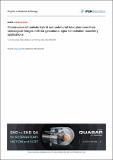Construction of realistic hybrid computational fetal phantoms from radiological images in three gestational ages for radiation dosimetry applications
Author
Makkia, Rasha; Nelson, Keith; Zaidi, Habib; Dingfelder, Michael
Abstract
Radiation exposure and associated radiation risks are major concerns for fetal development for
pregnant patients who undergo radiation therapy or diagnostic imaging procedures. In order to
accurately estimate the radiation dose to the fetus and assess the uncertainty of fetal position and
rotation, three hybrid computational fetus phantoms were constructed using magnetic resonance
imaging (MRI) for each fetus model as a starting point to construct a complete anatomically accurate
fetus, gravid uterus, and placenta. A total of 27 fetal organs were outlined from radiological images
via the Velocity Treatment Planning System. The DICOM-Structure set was imported to Rhinoceros
software for further reconstruction of 3D fetus phantom model sets. All fetal organ masses were
compared with ICRP-89 reference data. Our fetal model series corresponds to 20, 31, and 35 weeks of
pregnancy, thus covering the second and third trimester. Fetal positions and locations were carefully
adapted to represent the real fetus locations inside the uterus for each trimester of pregnancy. The
new series of hybrid computational fetus models together with pregnant female models can be used
in evaluating fetal radiation doses in diagnostic imaging and radiotherapy procedures.
Date
2019-10-10
Citation:
APA:
Makkia, Rasha, & Nelson, Keith, & Zaidi, Habib, & Dingfelder, Michael. (October 2019).
Construction of realistic hybrid computational fetal phantoms from radiological images in three gestational ages for radiation dosimetry applications.
,
(),
-
. Retrieved from
http://hdl.handle.net/10342/8054
MLA:
Makkia, Rasha, and Nelson, Keith, and Zaidi, Habib, and Dingfelder, Michael.
"Construction of realistic hybrid computational fetal phantoms from radiological images in three gestational ages for radiation dosimetry applications". .
. (),
October 2019.
June 29, 2024.
http://hdl.handle.net/10342/8054.
Chicago:
Makkia, Rasha and Nelson, Keith and Zaidi, Habib and Dingfelder, Michael,
"Construction of realistic hybrid computational fetal phantoms from radiological images in three gestational ages for radiation dosimetry applications," , no.
(October 2019),
http://hdl.handle.net/10342/8054 (accessed
June 29, 2024).
AMA:
Makkia, Rasha, Nelson, Keith, Zaidi, Habib, Dingfelder, Michael.
Construction of realistic hybrid computational fetal phantoms from radiological images in three gestational ages for radiation dosimetry applications. .
October 2019;
():
.
http://hdl.handle.net/10342/8054. Accessed
June 29, 2024.
Collections

